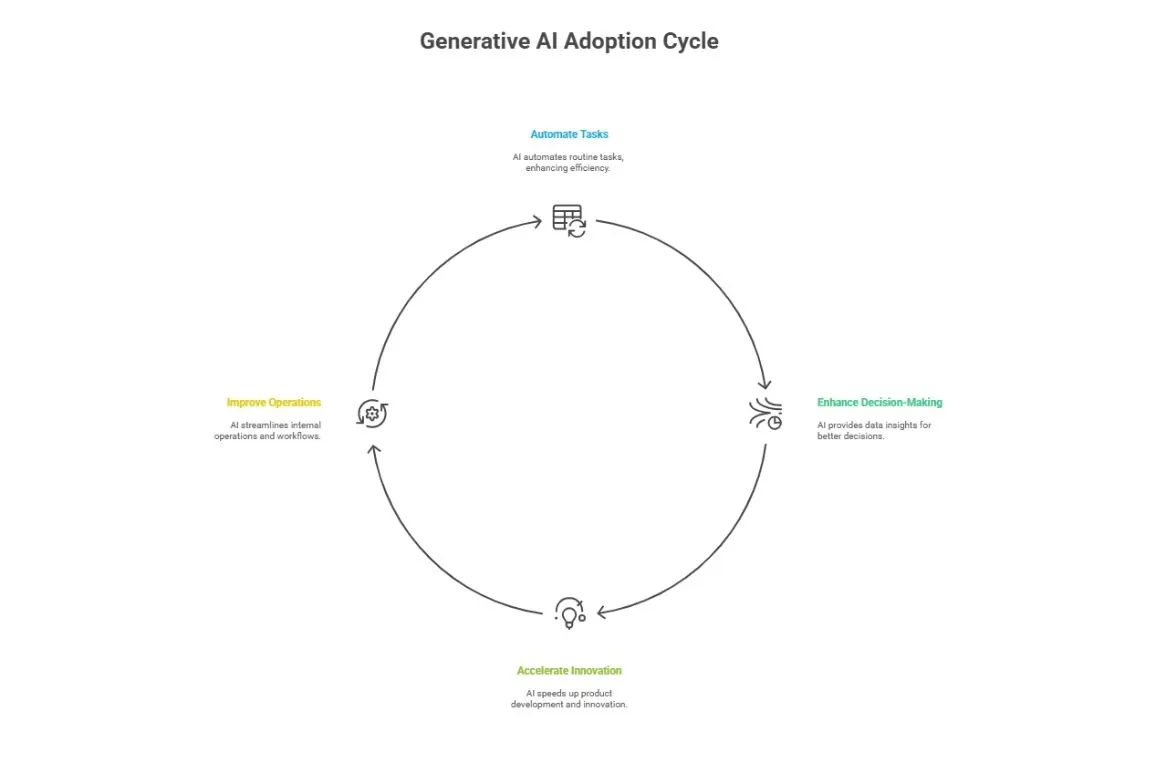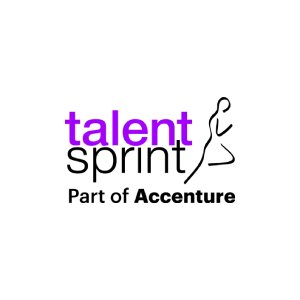Not Just a Buzzword: How Generative AI Is Fueling Smarter Businesses and Transforming Them?

Generative AI is not just another tech upgrade, in fact, it is a mindset shift. From Flipkart's personalized product recommendations to TCS building Gen AI copilots for software teams, Indian companies are embracing AI not just as a tool but as a coworker. Whether it’s writing marketing campaigns, designing interfaces, or solving customer queries at scale, Gen AI is helping businesses work smarter, not harder.
That’s why companies have stopped asking, "What is generative AI?" Instead, they are putting more emphasis on "How can we use it to stay ahead?"
What is generative AI, and why does it matter for businesses
Generative artificial intelligence is a groundbreaking branch of AI that creates original content by learning patterns from huge datasets. It goes beyond just analyzing information - it creates brand new outputs that mirror human creativity.
For companies, this means skipping the blank page and moving straight to high-impact solutions. In today’s market, speed and originality win, and Gen AI delivers both at scale.
Why does it matter for business?
- It speeds up the process of content Creation: Many Indian companies today are using generative AI to create content quickly and efficiently.
- This technology can create wonders, and it actually works well for enhancing customer interactions with Personalized Support.
- Generative AI, in a literal sense, works like a virtual Assistant to boot creativity.
- It helps reduce and cut costs and saves time by automating tasks.
How are businesses using generative AI?

Companies of all sizes are adopting generative AI faster to stay ahead of the competition. These real-life applications boost business performance by automating daily tasks and reshaping product development.
Automating content creation and customer support
Imagine a digital concierge who is always on and ready to help. That's AI-powered customer support, instant solutions, and personalized communication 24/7.
For Example, Swiggy and Zomato leverage AI chatbots to resolve delivery queries quickly, while also using AI to generate smart push notifications and content for campaigns.
Enhancing decision-making with data insights
Generative AI turns complex data into useful information. The system analyzes IoT devices, transactions, and social media feeds live. These models catch fraud patterns that old methods miss, making finance and e-commerce more secure. The system helps predict what customers want, manages inventory better, and sets prices by studying how people shop in different situations.
Accelerating product development and innovation
Forget long, drawn-out design processes. Generative AI is like a tireless brainstormer, helping your teams prototype, refine, and test new ideas at lightning speed. From car dashboards to app features, it fuels innovation, giving you a competitive edge.
Improving internal operations and workflows
Behind the scenes, Generative AI is streamlining everyday operations. From summarizing long customer calls to automating repetitive reports, it’s freeing up teams to focus on creative, meaningful work. Think of it as an invisible engine quietly powering a faster, smoother workplace.
For example, HDFC Bank uses AI tools to summarize calls, extract key insights, and reduce agent workload in customer support.
Industry-specific applications of generative AI
Generative AI shows its adaptability in a variety of industries by solving unique challenges. Companies use AI applications to create individual-specific experiences and automate complex processes, which reshapes the scene of their operations.
Retail: Personalization and inventory optimization
AI helps retailers create highly targeted shopping experiences that shape buying decisions.
Flipkart and Myntra use AI to provide personalized recommendations based on user behavior and purchase history. Myntra’s “MyFashionGPT” uses generative AI to help users find outfit suggestions conversationally.
Healthcare: Drug discovery and diagnostics
Generative AI has reshaped drug discovery in the pharmaceutical sector by reducing development time and costs. It helps scientists discover new medicines faster and assists doctors in spotting things in medical scans that might otherwise go unnoticed. It’s making diagnoses smarter and treatments more targeted.
Finance: Fraud detection and compliance
Banks use generative AI to curb sophisticated fraud attempts. This technology improves fraud detection by creating synthetic data that helps balance datasets and enhance modelling techniques. AI-powered risk management tools analyze transactions for fraud patterns and send immediate alerts. Yes, it is helpful in fraud investigations as it summarizes activities, examines evidence, and suggests next steps.
Manufacturing: Predictive maintenance and quality control
In manufacturing, AI is the operations wizard. It predicts when machines need repairs before they break, and ensures quality checks are sharper and more consistent. This leads to less downtime, fewer defects, and more efficient production lines. Tata Steel uses AI-powered predictive maintenance to monitor equipment and reduce unplanned downtime.
Education: Adaptive learning and content generation
Schools use generative AI to build learning paths that adapt to each student's performance. These systems adjust difficulty based on learning speed, which leads to better engagement, test scores, and faster skill development. AI also helps create custom educational materials. This reduces teachers' workload and lets them focus on teaching rather than making content.
How is generative AI transforming businesses?
"Generative AI is shifting business from being reactive to being relentlessly innovative."
Generative AI has become a game-changer that revolutionizes how businesses operate at their core. This remarkable potential drives strategic business changes in multiple ways.
Moving from task automation to strategic enablement
Generative AI's influence reaches beyond simple task automation. Companies now transform their core workflows to align with strategic priorities instead of running isolated pilots. This development helps organizations discover the potential of automation, data combination, and unstructured information processing in unprecedented ways. Businesses can now concentrate on strategic initiatives while AI handles more than half of their employees' routine tasks.
Creating new business models and revenue streams
Generative AI is opening up fresh possibilities for Indian businesses. It’s helping companies improve their work and build entirely new services.
For example, Reliance Jio is developing AI-powered assistants and personalized content experiences across its telecom and retail platforms.
Boosting customer experience at scale
From shopping to banking to food delivery, generative AI is making every customer interaction more personal and more efficient.
Across industries, AI is helping brands move from mass communication to 1:1 experiences at scale.
Speeding up time-to-market
In a market as fast-paced as India’s, speed is everything. Generative AI is giving companies a competitive edge by reducing time spent on repetitive tasks and allowing teams to move from idea to execution faster than ever before. Bringing a product or service to market takes time, but AI is helping teams move faster than ever.
What is the biggest challenge facing organizations that want to implement generative AI?
Organizations are racing to adopt generative AI, but major implementation challenges can derail promising initiatives. Success depends on understanding these obstacles before deployment to create lasting business value.
Change management and cultural resistance
Employee resistance remains the biggest barrier to generative AI adoption. Employees often fear job losses and feel uncomfortable with new work processes. Companies that create complete change management strategies get better results. Their leadership and employees align to achieve more ROI wins. Companies must show how AI increases human capabilities rather than replaces workers to encourage ownership and trust.
Sceptics' early involvement in the AI trip can reveal blind spots that eager early adopters might miss. When properly channeled, this resistance often leads to innovation. Teams think more critically about limitations and develop creative solutions.
Data quality and governance issues
Poor data quality lurks beneath many failed AI implementations. Common problems include:
- Unlabeled or poorly labelled datasets without context
- Incomplete data and missing values that hurt model performance
- Inconsistent formats that create confusion during model training
Strong data governance frameworks are crucial to generate reliable AI outputs and meet compliance standards.
Integration with legacy systems
In India’s customer-first landscape, AI is helping brands build deeper, more meaningful relationships with their users. While customers love personalization, they also expect transparency. Companies are focusing on building trust by using human-in-the-loop systems and explaining how AI-based suggestions work.
Lack of skilled talent and training
In a market as fast-paced as India’s, speed is everything. Generative AI is giving companies a competitive edge by reducing time spent on repetitive tasks and allowing teams to move from idea to execution faster than ever before. With AI tools doing the heavy lifting on repetitive tasks, teams can focus more on ideas, innovation, and impact.
How can business leaders get started with generative AI today?
Organizations succeed with generative AI through careful planning rather than quick technology decisions. Many companies fail because they rush into technical solutions without proper preparation. Business leaders should follow a structured path to adopt generative AI successfully.
Identify high-impact use cases.
Your organization should focus on specific business problems instead of technology capabilities. Define which AI tools you'll use and their purpose. The implementation works best when you identify use cases that bring the highest potential ROI to your business. Look for areas where generative AI can solve existing challenges or create competitive advantages. Success comes from answering specific business questions your organization needs to solve. This helps you focus on applications that advance your core mission.
Start with pilot projects.
Small, focused initiatives that deliver clear value work best. Your team should set quality standards to evaluate AI outputs, including accuracy, fairness, and brand voice alignment. You should remove underperforming pilots and expand those that show technical feasibility and business value. This method lets you test concepts quickly without expensive investments in unproven applications.
Build cross-functional AI teams.
Your AI teams should include data scientists, domain experts, IT specialists, and business leaders. Companies achieve better results when AI projects involve collaboration across departments. The team needs technical skills and an environment where members share ideas freely without fear. Regular sessions, workshops, and internal documentation help create this collaborative atmosphere.
Invest in data infrastructure.
A reliable data foundation must exist before scaling AI initiatives. Data readiness needs two key elements: automated data movement capabilities and proper governance frameworks. Your infrastructure should protect data privacy while reducing risks from large language models. This base supports current applications and future AI innovations.
Ensure ethical and responsible AI use.
Your organization needs detailed AI policies that address ethical considerations, data privacy, and professional integrity. Regular policy reviews should reflect the latest ethical standards and regulatory requirements. Humans must remain the decision-makers in every AI-powered initiative. A public statement about your organization's dedication to responsible AI use builds trust with customers and stakeholders.
Conclusion: Lead your business with generative AI.
Generative AI is pioneering business transformation. It's not just another passing technology trend but marks a radical alteration in how organizations operate. This article showcased how this powerful technology creates real business value. It automates routine tasks and reimagines entire business models.
But Success doesn't depend on technology alone. Organizations need thoughtful implementation strategies that align with specific business goals.
Companies succeeding with generative AI share common traits. They begin with well-defined use cases instead of technology-first approaches. Their cross-functional teams blend technical expertise with domain knowledge. These organizations also build strong data governance frameworks to ensure quality inputs and ethical outputs.
But Finding the right balance is crucial and Generative AI offers incredible promise. Yet substantial challenges exist. Teams face talent shortages, data quality issues, and integration complexities. Your organization should take a methodical approach. A Generative AI in Business can give you that fluency. It’s where business meets AI, and where learners become leaders, armed with real-world tools, insights, and confidence to drive change.
It’s clear: Generative AI is no longer optional for forward-thinking businesses. But knowing what it is isn’t enough. The real value lies in learning how to apply it to your team, your goals, and your strategy.
Frequently Asked Questions
Q1. How is generative AI transforming business operations?
Generative AI is revolutionizing business operations by automating content creation, enhancing decision-making with data insights, accelerating product development, and improving internal workflows. It's enabling businesses to create personalized customer experiences, develop new products faster, and optimize processes across various industries.
Q2. What are the key challenges in implementing generative AI?
The main challenges include managing cultural resistance to change, ensuring data quality and governance, integrating with legacy systems, and addressing the shortage of skilled AI talent. Overcoming these obstacles requires strategic planning, robust data infrastructure, and comprehensive training programmes.
Q3. How can businesses start implementing generative AI?
To begin with generative AI, businesses should identify high-impact use cases, start with pilot projects, build cross-functional AI teams, invest in data infrastructure, and ensure ethical AI use. It's crucial to focus on specific business problems rather than technology capabilities and to start with small, focused initiatives that deliver clear value.

TalentSprint
TalentSprint is a leading deep-tech education company. It partners with esteemed academic institutions and global corporations to offer advanced learning programs in deep-tech, management, and emerging technologies. Known for its high-impact programs co-created with think tanks and experts, TalentSprint blends academic expertise with practical industry experience.



